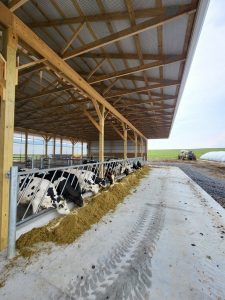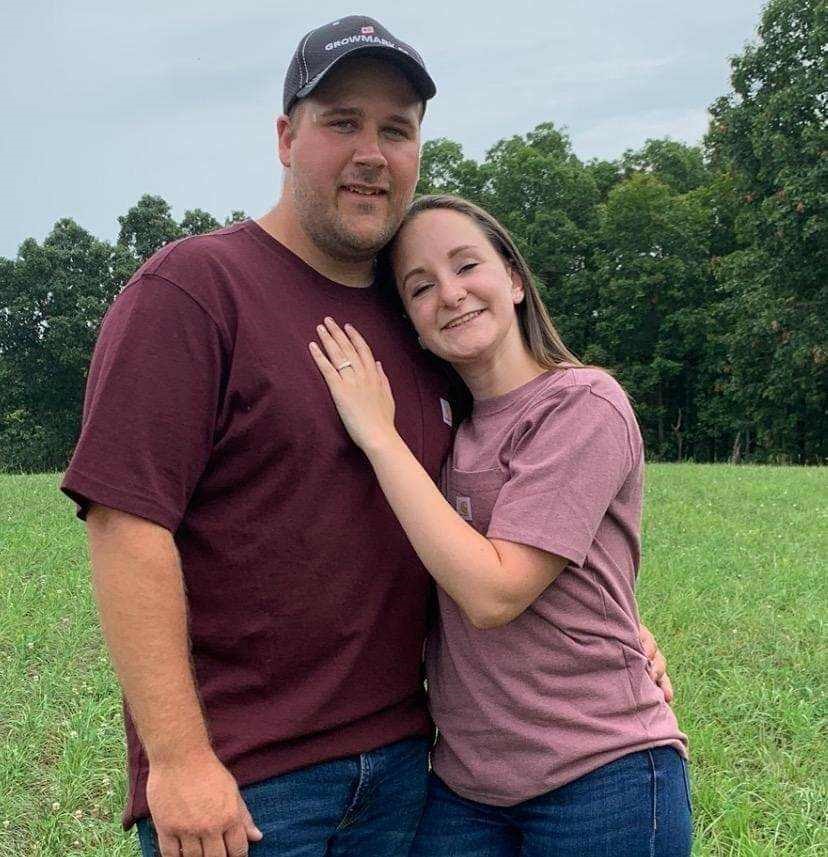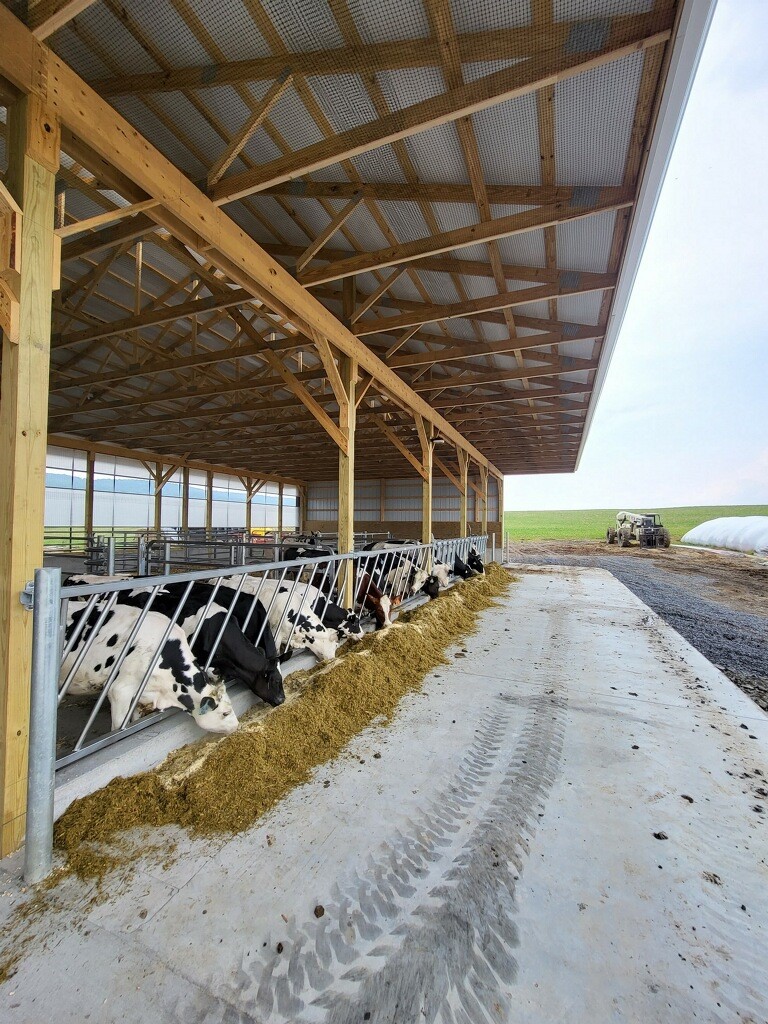
Donald and Gabrielle Miller don’t have a traditional background in dairy farming, but what they do have is a burning passion for the dairy industry and the courage to start their own operation from scratch. Growing up in Blair County, Pennsylvania, Donald has years of hands-on, boots-on-the-ground experience at local dairy farms. Gabrielle spent a few years studying to become a nurse. Neither had a family farm to join, but after making the leap in 2021, the couple started Miller Family Farm in Williamsburg, Pa.
“We basically started from the ground up. The farm we have now had been rented out for the last 35 years. I previously worked on other dairy farms [in the area], and I’ve always wanted to milk cows of my own ever since I was little,” Donald shared. “I decided to do it now instead of being 40 years old and looking back wishing I had tried it.”
“I went to school to be a registered nurse, so I have no background in farming. I came into it with a fresh slate and take each day as a learning experience. We’ve definitely found our places on the farm and in the barn. It works out well for us,” Gabrielle added.
Now two years into their venture, the Millers have about 75 cows and 100 tillable acres. They grow corn, alfalfa and a springtime cover crop, which is normally wheat. Donald is responsible for the fieldwork along with feeding, scraping and bedding. Gabrielle manages the cows, heifers and reproduction. Both of them help with milking. While they are excited about their progress, the journey to starting a dairy farm from scratch has not been easy. From buying their own cows and equipment to taking loans out to build barns, it has been an all-in investment for both of them.
Donald says family has been one of their biggest sources of support. He started building the free-stall barn with his dad in October 2021 when lumber was expensive, but fortunately, milk prices were high across the industry. Their barn has 84 free stalls, and they milk in a six-cow, step-up parlor.
“[Starting from scratch] was the hardest thing. We have a lot of neighbors who are taking over for their fathers or uncles, so for us, it was hard to see all the overhead going into it at first,” Donald said. “The first year is always going to be the hardest. This October will be two years since we’ve started, so it seems like it has been going by pretty quick.”

As they were getting started, Donald and Gabrielle sought out a professional who could help them with business planning and cash flow analysis. They were paired with Dr. Charlie Gardner, a consultant from the Center for Dairy Excellence.
“I needed help with a business plan and cash flow plan. Charlie even came out to the farm one time and looked things over. He really helped us to keep the process moving. Without Charlie, I probably wouldn’t be doing this,” Donald shared.
They both agree that developing business plans, analyzing cash flow, and applying for loans takes time. Patience is key, especially when their goal is to make the business sustainable for the long haul.
“When we were doing the cash flow analysis, it took six to eight months until we were finally completed with our loan. It doesn’t happen overnight. We had to be patient,” Donald explained. “I plan on doing this for the rest of my life, not just for a year. To make this work, I think having a business plan and keeping an eye on the financials is key.”
The Millers have also learned the importance of re-evaluating their business plan over time and not being afraid to change course. For example, they started out not raising their own replacements but have slowly evolved and developed their heifer operation.
“In our original business plan, we were not supposed to raise replacements. At that time, it was cheaper to buy. As we went on in our first year, cow prices kind of went through the roof and we learned it was not cheaper to buy – especially in our situation just starting and having to buy our herd fresh,” Gabrielle said. “Continually bringing in more animals was not working for our situation, so we slowly pieced together our heifer operation.”
With an eye on their finances, Gabrielle says they had to be frugal and business-minded with some of their decisions. They bought calf pens from a local farmer who was leaving the business. They worked with a loan officer to create another business plan for a heifer barn and took out a second loan.
“It’s really hard starting from the bottom up. You have to find ways to be frugal. We feed our heifers raw milk twice a day, and they’re growing just fine. I think we have some very beautiful heifers right now,” Gabrielle said. “You only have so much money. You have to find out what’s going to work best for your price range. We have to keep looking toward the future because backwards is not an option. I’m not giving up. Sometimes it’s one month and moment at a time, and other times, we can sit down and think about the next step because we’re finally caught up.”

Their calves stay in their pens until about four months and then move to a transition pen from about four to six months. After that, they go to the heifer barn which has four pens. Their herd includes also mixed breeds, which Gabrielle is excited about. “Each animal brings their own components to the game,” she added. For the first time this coming February, they will have their own heifers on the farm become milk cows.
“If you want to start from the bottom up, you can’t have everything at once. You have to be okay with that. We didn’t have a heifer barn at first, but now we do. Maybe in three years, we’ll be able to build a dry cow barn and be able to take that step,” Gabrielle added.
For other young people who might be looking to get their start in the dairy industry, Donald says gaining experience on multiple types of dairy operations can be beneficial.
“There are similarities to dairy farms, but I’m a firm believer that every farm, person and situation is different. If school isn’t in the playbook for someone who wants to do this, getting some experience for a year or two on multiple dairy farms will truly get your hands dirty so to speak. You can really tell if it’s what you want to do,” Donald said.
Gabrielle’s advice for getting started is to be comfortable working with consultants and advisors – and not being afraid to implement their expertise.
“You need to have a good support system. You have to do your research. Have those people like Charlie, your loan officer, or other farmers in the area who can give you information. Don’t try to go into it blind like you know everything, because you don’t. This is not something simple to get into,” she added.
With so many steps involved in starting a dairy operation, what fuels Donald and Gabrielle to keep going? For Donald, it’s about proving himself and knowing that dairy farmers are the backbone of our communities.
“There were a lot of other dairy farmers that kind of told me they wouldn’t do this if they had to re-start. They told me it probably wouldn’t work starting with a fresh, clean slate like this,” he shared. “That kind of fueled my desire to want to do it. And I think we’re always going to need a dairy farmer, no matter what size you are.”
For Gabrielle, it’s also about the upbringing they will be able to provide for their growing family. They are expecting their first child – a boy – this fall. “We’re excited to be able to bring him up on the farm and allow him to see these things. A lot of kids think milk comes from the fridge or the store. Our kid will know exactly where it comes from. As a child, neither one of us had that, so I’m very excited to give him that opportunity,” she said.
If you’re interested in working with a consultant who has firsthand experience in the dairy industry, the Center can help. Email Melissa Anderson or call us at 717-346-0849 and we can put you in touch with a consultant who can help with business planning, transformation, transition planning and more. Grants may also be available to cover consulting fees.
Our “Getting Started in Dairy Farming” guide also provides 11 starting points and links to industry resources that should help you eventually own and manage your own herd of dairy cows. Click here to access the free guide.

